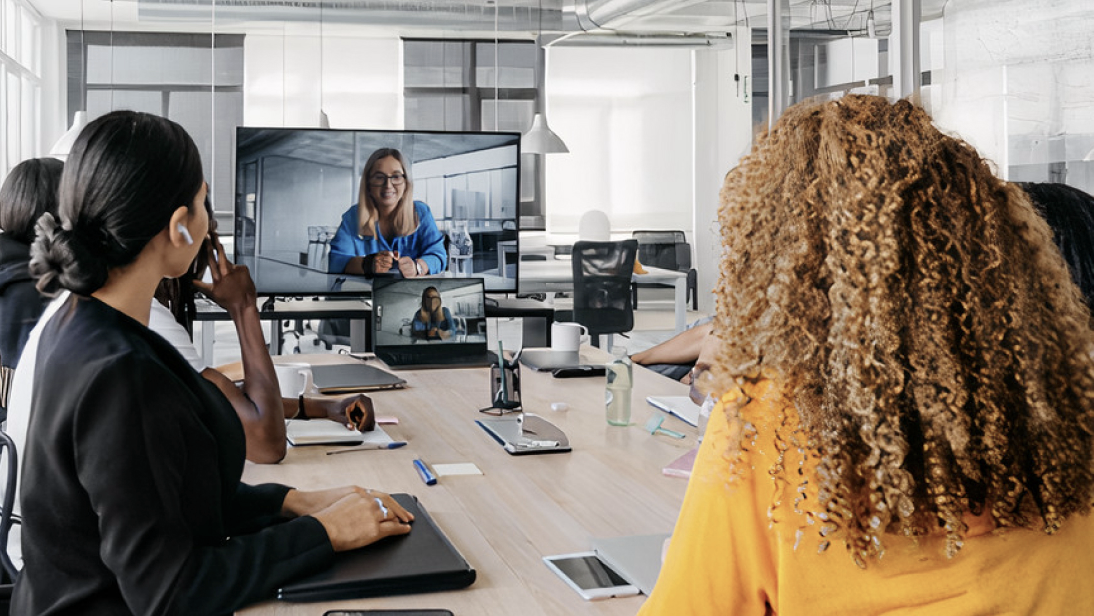As some teams head back into the office, many are facing a unique challenge for the first time - running a meeting where some team members are in-person and others are remote. After Zooming from home for months, many are very eager to get back to the conference room, but for various reasons, not all team members may be able to physically be there. This could be the reality for teams for quite some time, so it's worth investing some time and energy into getting the hybrid team meetings right.
The Challenges:
If you've ever participated in a meeting where you were remote and everyone else was in the room together, you know there are some significant challenges involved in this format.
-
Audio. Side conversations or cross-talk in the room are impossible to follow from the other end of the line. When things get heated and people are excited and talking fast or over each other, you are left in the dark.
-
Visuals. When everyone is remote, you're all looking at the same visual - whether it's a Brady Bunch-style view of each other's faces or whatever slide/screen the presenter has shared. Everyone has an equal view. In a hybrid meeting, it can be hard for people in the room to see the visuals on the conference room TV or projector and impossible for remote participants to read anything on the whiteboard or flipchart paper. Finding a visual medium for both audiences is tough.
-
Distractions. If everyone in the conference room is chatting or excitedly scribbling away on the whiteboard you can't see, it is very tempting to mute yourself and zone out - check emails or scroll social feeds or maybe turn off your video and fold that never-ending laundry pile. For those in the room, you're also probably not following along as closely as you'd be if everyone were on their laptops looking at the same screen. You also might be tempted to zone out, pay attention to who's walking by or get distracted by other in-office happenings.
Best Practices:
The good news is that a seasoned facilitator can turn a hybrid meeting from being a worst-of-both-worlds disaster to an engaging and productive meeting for all of the participants. Here are some tips for how you can do this, too.
-
Set some ground rules to level the playing field and ensure inclusivity. Here are some ground rules for you to consider:
-
All video on. Regardless of where you are joining from, ask everyone to bring their laptop and join with their video on (and audio off so you don't have echoes.) One person can join the audio, ideally connected to a video conferencing system with multiple microphones around the room. We also recommend using zoom icebreakers to get things started.
-
Remote first. Establish a norm that the remote people always share first anytime you go around the room. Encourage the team to remind you if you forget while facilitating. Having the remote team go first when sharing will ensure you don't forget about them (which is very common when you're "going around the room" if you don't have a visual cue to call on those remote team members.)
-
One person speaking at a time. For remote team members, ask them to mute when they are not speaking and use the "raise hand" feature if they want to share something. For people in the room, ask that only one person speak at a time. If you have a team that likes to interrupt or talk over each other or have side conversations, you can implement a physical "talking stick" that is the in-person equivalent of unmuting only one person at a time. This makes a big difference for remote people participating in the meeting to be able to hear and follow the discussion in the room and participate equally.
-
Minimize distractions. Ask everyone to put away phones, email and other distractions during the meeting, and agree to hold each other accountable. Ask people joining remotely to keep their video on the whole time, unless they need to step away briefly.
-
Say it now... or never. Establish a norm where you say everything, even the hard stuff, in the meeting. When you are in the office together, it can be tempting to save your real thoughts for the hallway conversation after the fact. This robs your virtual participants of the opportunity to engage in the actual discussion.
-
-
Invest in the right tools and equipment. Having the right tools will set you up for success in the new world of hybrid meetings.
-
Audio. Make sure your conference room is equipped with a quality audio system with multiple microphones so that you can safely socially distance in your conference room and everyone joining remotely can still hear each person. If you don't have a system that works and can't invest in one, consider having each person join from their office instead of using the conference room to keep everyone safe and able to hear during the meeting.
-
Visuals. Having everyone join with their individual laptop, even if they are in the conference room, will ensure everyone can see the presenter's screen. Design your visuals with this in mind. Sharing slides or dashboards like Rhythm software work great in this meeting environment. Rather than brainstorming with physical markers and flipchart or whiteboard, experiment with some online tools for brainstorming and collaborating. Google Docs, a virtual whiteboard like Mural or Miro, or even the whiteboard on your Zoom application could be alternatives. If you are absolutely hooked on the whiteboard in your conference room and NEED to use it, set up a camera specifically capturing the whiteboard, close enough for people to see it. Test it in advance to be sure anyone joining remotely can read every word on that whiteboard.
-
Purpose. In addition to investing in the right equipment and technology, invest the necessary time to agree on the purpose of the meeting in advance. Use an objective statement or simply complete the sentence, "This meeting will be successful if..." to ensure you are all aligned on the purpose of the meeting and what you are there to accomplish together. Establishing and communicating the purpose will go a long way to setting the stage for an effective meeting, and if you can't come up with a compelling reason to meet, you can cancel the meeting and give everyone the gift of time.

-
-
Embrace the advantages of both modalities. There are some real advantages to both remote and in-person meetings - maximize your hybrid meeting by capitalizing on both.
-
Encourage informal connection. Start the Zoom at least 15 minutes early so remote team members can join, test their technology, and participate in the informal conversations that naturally happen as team members come into the conference room. Leave a buffer time if anyone wants to linger and chat after the meeting ends rather than ending the Zoom and leaving people at home feeling that they've missed out.
-
Stick to a focused agenda. Virtual meetings and Zoom fatigue have forced most of us to get very tight on what we are there to accomplish in a meeting. Keep this discipline and focus and don't be tempted to slip back into old habits with meandering meetings just because you're back in the conference room. We occasionally use timer apps to help us stay on track with timing and ensure that nobody on the team dominates the speaking time in the meeting.
-
Enlist help. If you are overwhelmed with all the moving parts involved in facilitating the meeting—running the visuals, coordinating the technology, capturing notes and follow up items, and enforcing the ground rules— assign helpers, ideally someone in the conference room to help with technology or keeping side conversations in check and someone remote to help with capturing notes or follow up tasks. Engaging team members in specific tasks to help the meeting run more smoothly and will ensure it is more productive for everyone and less stressful for you.
-
-
Rate the meeting. As your team is figuring out a new format, it's a best practice to collect some feedback from the participants. An easy way to do this is to ask everyone to write down a number 1-10 to rate the meeting's effectiveness. Ask each person to share their number and a short sentence explaining why they gave that number. You can collect these after the fact and read them or save the last five minutes to share in the meeting. Use this feedback from the team to ensure you've done a good job including everyone and make adjustments to improve as you learn what works and what doesn't for your hybrid team.
If possible, the meeting facilitator should try participating at least once remotely and in-person to really understand both sides of the experience. For me, that was a real light bulb moment. I've been running our monthly, company-wide meeting for years, and it has always been in a hybrid format. It wasn't until one of my daughters was sick, and I had to join from home that I realized just how painful the experience was for our remote team members. They never complained, but after I sat in their seats, we made many of the adjustments above to ensure they could participate more fully and enjoy the time with the team.
Here are other blogs to help with virtual meetings:
Zoom facilitation: host a virtual meeting like a pro
15 Zoom Tips and Tricks for Your Virtual Meeting
How the Best Remote Team Fight Zoom Fatigue
Virtual Strategic Planning: 7 Tips for a Great Strategic Planning Session
Photo Credit: Stocksy




